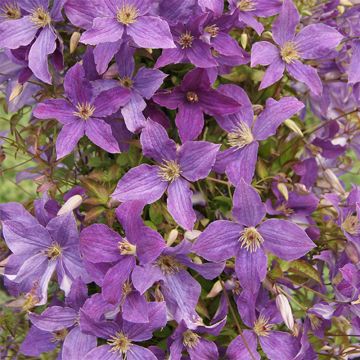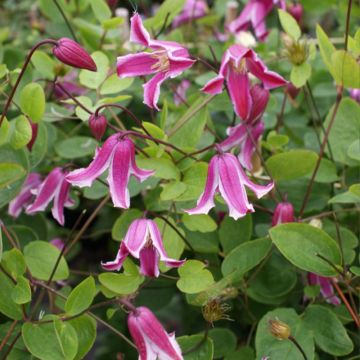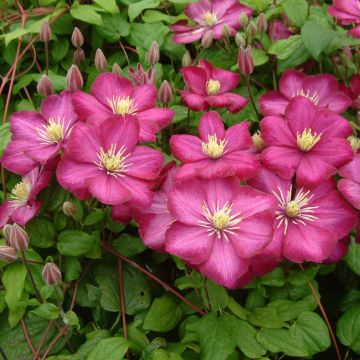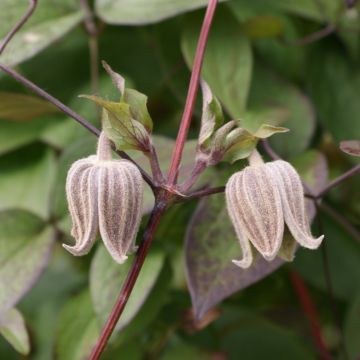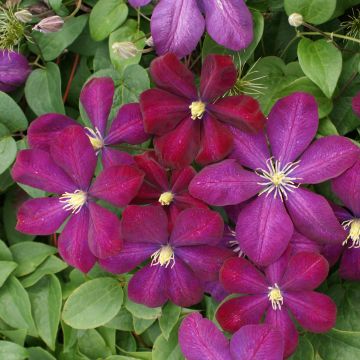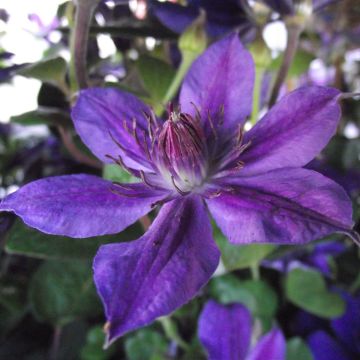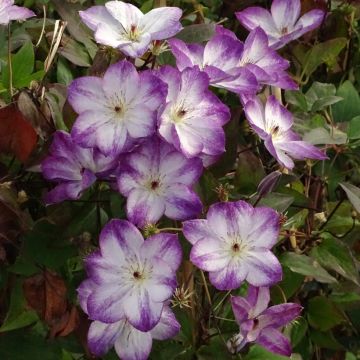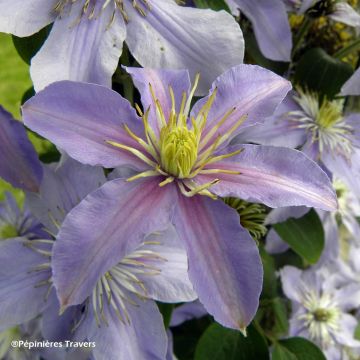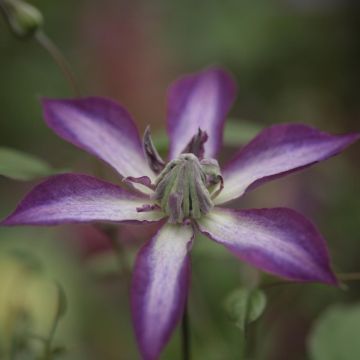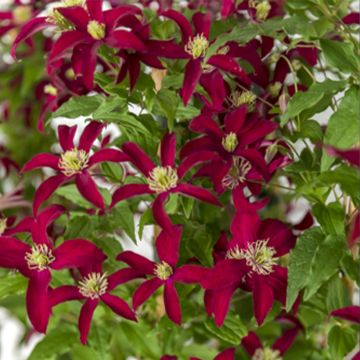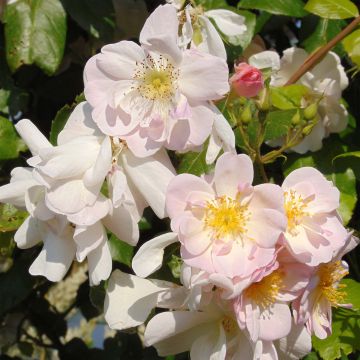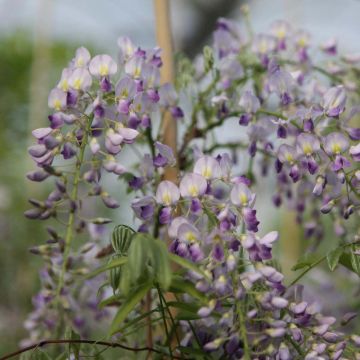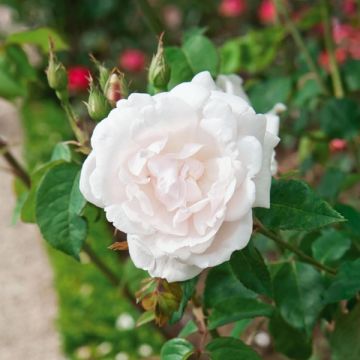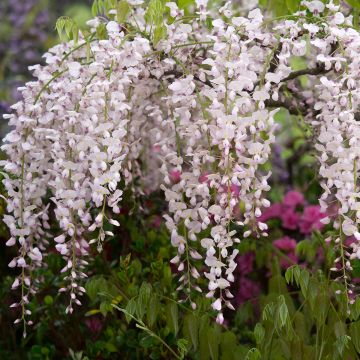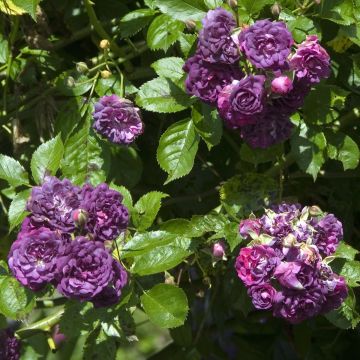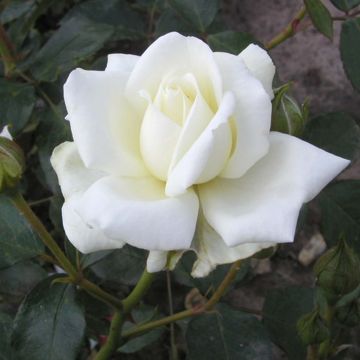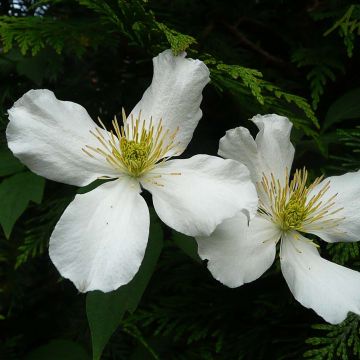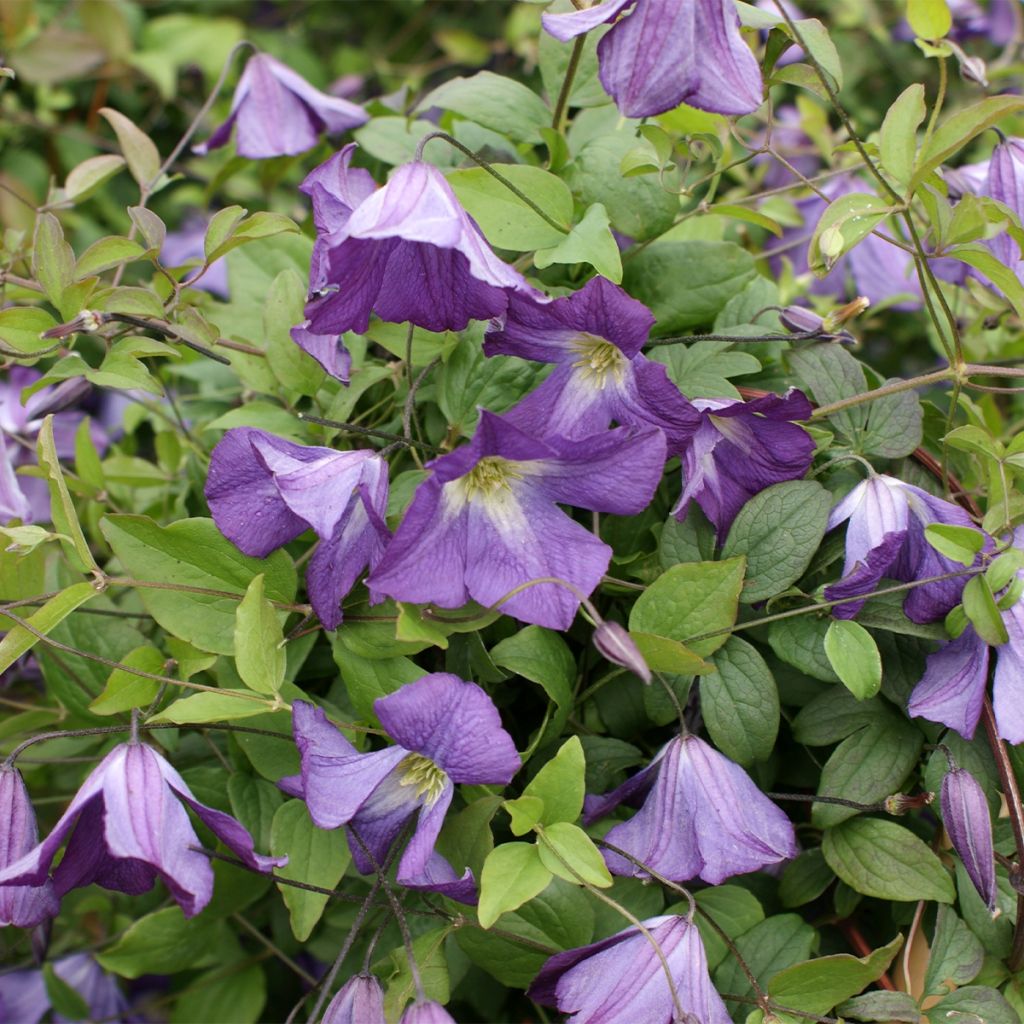

Clematis x viticella Little Bas
Clematis x viticella Little Bas
Clematis x viticella Little Bas
This item cannot be shipped to the selected country
Delivery charge from €5.90
More information
Schedule delivery date,
and select date in basket
This plant carries a 6 months recovery warranty
More information
We guarantee the quality of our plants for a full growing cycle, and will replace at our expense any plant that fails to recover under normal climatic and planting conditions.
From €5.90 for pickup delivery and €6.90 for home delivery
Express home delivery from €8.90.
Does this plant fit my garden?
Set up your Plantfit profile →
Description
Clematis 'Little Bas' is a variety derived from C. viticella, from which it inherited robustness and ease of cultivation. Its simple and bell-shaped flowers are of modest size, but are produced abundantly throughout summer. They are a lovely violet-blue with pink highlights, hiding an interior adorned with a white star pattern that plunges into a wide white throat. This healthy clematis is easy to grow in many situations, and its rather moderate development is suitable for small gardens. It is stunning when planted with a pink rose.
Clematis belong to the Ranunculaceae family. They are found in Europe, the Himalayas, China, Australia, and North and Central America. The 'Little Bas' variety was obtained in 2000 in the Netherlands. Its ancestor, Clematis viticella, native to Southern Europe, is known for its natural resistance to clematis wilt. It is a perfectly perennial, semi-woody and climbing herbaceous plant, which will reach an average height of 2.5m (8ft) (sometimes more than 3m (10ft)), with a minimum spread of 1m (3ft). This clematis bears semi-open flowers, reaching 5 to 6cm (2in) in diameter. They appear in successive waves on the current year's shoots, from June to the end of summer. The flowers are solitary or grouped in small bouquets. They have 4 wide, undulating, curled sepals with a crepe-like texture. The centre of the flower is adorned with a small crown of cream-white stamens. The olive-green and glabrous leaves are divided into 3 elliptical to lanceolate leaflets. The deciduous foliage dries up in winter. This clematis clings to support or the host plant through petioles transformed into tendrils.
Plant your clematis together with climbing or rambling roses ('New Dawn', 'Pomponella', 'Bouquet Parfait') to extend the flowering period of walls and pergolas until the end of summer. It is a diverse genus, with colours, shapes, and sizes of all kinds. Take advantage of their ease of cultivation to give your garden a romantic and bohemian touch. 'Little Bas' will blend well with the climbing rose 'Pink Cloud', the pink flowers of Clematis 'Patricia Ann Fretwell' or C. 'Little Mermaid', for example. These small climbers all have the same stature, and can be used to climb a fence or cover a wall exposed to the morning sun. Italian clematis tolerate wind well and are excellent varieties to plant at the base of hedges.
Avoid use of excessive fertiliser, as this stimulates foliage growth at the expense of flowers. Do not mulch in order to avoid excessive moisture.
Report an error about the product description
Clematis x viticella Little Bas in pictures
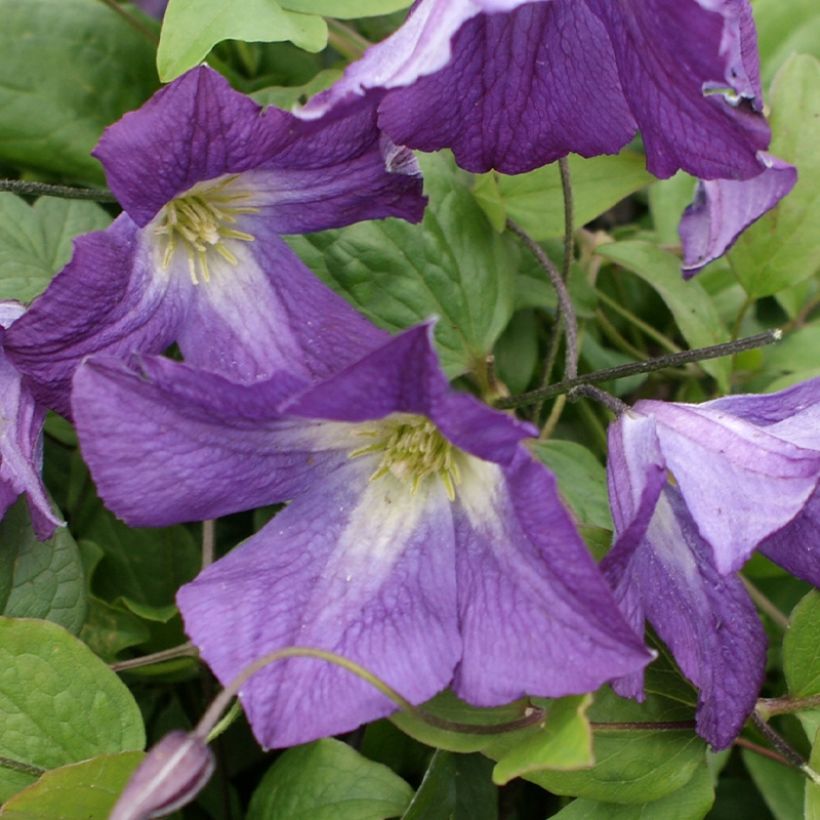

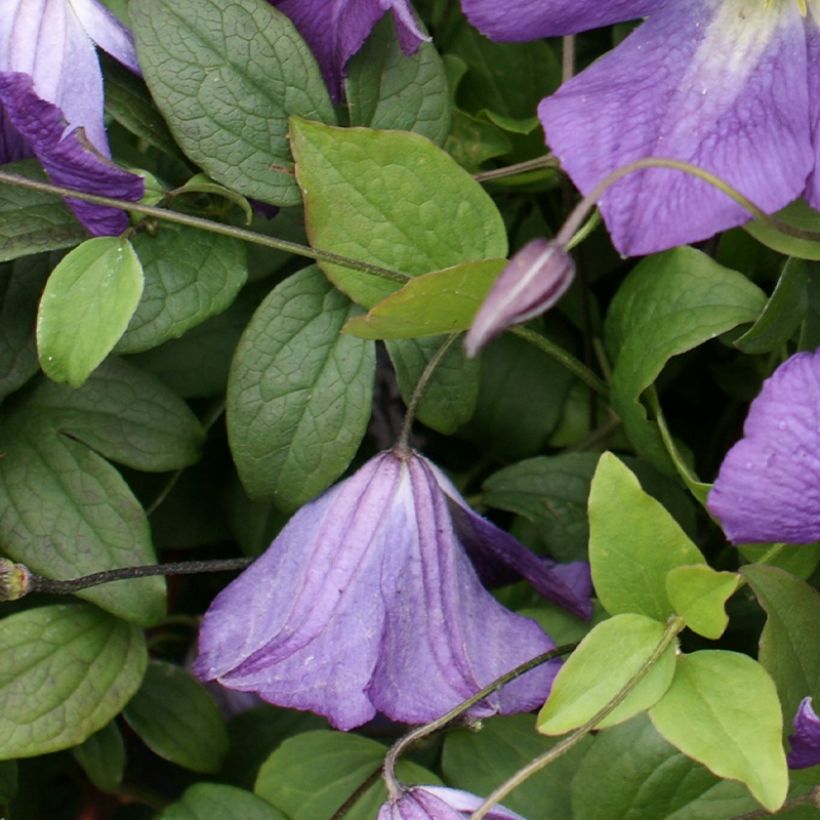

Plant habit
Flowering
Foliage
Botanical data
Clematis
x viticella
Little Bas
Ranunculaceae
Cultivar or hybrid
Other Clematis Viticella
Planting and care
Clematis 'Little Bas' prefers partially shaded situations that prevent its flowers from fading too quickly. It even accepts flowering in bright shade. Plant it in fertile, humus-rich, well-drained soil, shading the roots and base of the stem (with a flat tile, for example). Clematis wilts in overly wet soil, but varieties with the genes of C. viticella are more resistant to this terrible disease. They also tolerate heat and dry soils better in summer.
Plant it in well-worked soil enriched with good compost and coarse sand. Plant it with the rootball at an angle, covering it with 3cm (1in) of soil. After planting, cut back the stems to about 30cm (12in) from the base, above a pair of buds. Water regularly and generously during the first few weeks. Do not overwater, as stagnant water can lead to the development of fungus at the base of the plant.
Mulch all clematis in February with garden compost or well-rotted manure, avoiding direct contact with the stems.
Train the stems, without squeezing them, until the plant clings by itself. Clematis also like to grow freely on neighbouring plants.
After a few years, cover the base of your climbing clematis with a small mound of soil to reduce the risk of withering while encouraging vigorous shoots from the stump.
Voles and grey worms can attack clematis and devour the stems. Aphids and greenhouse whiteflies are also potential parasites.
Planting period
Intended location
Care
-
, onOrder confirmed
Reply from on Promesse de fleurs
Foolproof climbers
Haven't found what you were looking for?
Hardiness is the lowest winter temperature a plant can endure without suffering serious damage or even dying. However, hardiness is affected by location (a sheltered area, such as a patio), protection (winter cover) and soil type (hardiness is improved by well-drained soil).

Photo Sharing Terms & Conditions
In order to encourage gardeners to interact and share their experiences, Promesse de fleurs offers various media enabling content to be uploaded onto its Site - in particular via the ‘Photo sharing’ module.
The User agrees to refrain from:
- Posting any content that is illegal, prejudicial, insulting, racist, inciteful to hatred, revisionist, contrary to public decency, that infringes on privacy or on the privacy rights of third parties, in particular the publicity rights of persons and goods, intellectual property rights, or the right to privacy.
- Submitting content on behalf of a third party;
- Impersonate the identity of a third party and/or publish any personal information about a third party;
In general, the User undertakes to refrain from any unethical behaviour.
All Content (in particular text, comments, files, images, photos, videos, creative works, etc.), which may be subject to property or intellectual property rights, image or other private rights, shall remain the property of the User, subject to the limited rights granted by the terms of the licence granted by Promesse de fleurs as stated below. Users are at liberty to publish or not to publish such Content on the Site, notably via the ‘Photo Sharing’ facility, and accept that this Content shall be made public and freely accessible, notably on the Internet.
Users further acknowledge, undertake to have ,and guarantee that they hold all necessary rights and permissions to publish such material on the Site, in particular with regard to the legislation in force pertaining to any privacy, property, intellectual property, image, or contractual rights, or rights of any other nature. By publishing such Content on the Site, Users acknowledge accepting full liability as publishers of the Content within the meaning of the law, and grant Promesse de fleurs, free of charge, an inclusive, worldwide licence for the said Content for the entire duration of its publication, including all reproduction, representation, up/downloading, displaying, performing, transmission, and storage rights.
Users also grant permission for their name to be linked to the Content and accept that this link may not always be made available.
By engaging in posting material, Users consent to their Content becoming automatically accessible on the Internet, in particular on other sites and/or blogs and/or web pages of the Promesse de fleurs site, including in particular social pages and the Promesse de fleurs catalogue.
Users may secure the removal of entrusted content free of charge by issuing a simple request via our contact form.
The flowering period indicated on our website applies to countries and regions located in USDA zone 8 (France, the United Kingdom, Ireland, the Netherlands, etc.)
It will vary according to where you live:
- In zones 9 to 10 (Italy, Spain, Greece, etc.), flowering will occur about 2 to 4 weeks earlier.
- In zones 6 to 7 (Germany, Poland, Slovenia, and lower mountainous regions), flowering will be delayed by 2 to 3 weeks.
- In zone 5 (Central Europe, Scandinavia), blooming will be delayed by 3 to 5 weeks.
In temperate climates, pruning of spring-flowering shrubs (forsythia, spireas, etc.) should be done just after flowering.
Pruning of summer-flowering shrubs (Indian Lilac, Perovskia, etc.) can be done in winter or spring.
In cold regions as well as with frost-sensitive plants, avoid pruning too early when severe frosts may still occur.
The planting period indicated on our website applies to countries and regions located in USDA zone 8 (France, United Kingdom, Ireland, Netherlands).
It will vary according to where you live:
- In Mediterranean zones (Marseille, Madrid, Milan, etc.), autumn and winter are the best planting periods.
- In continental zones (Strasbourg, Munich, Vienna, etc.), delay planting by 2 to 3 weeks in spring and bring it forward by 2 to 4 weeks in autumn.
- In mountainous regions (the Alps, Pyrenees, Carpathians, etc.), it is best to plant in late spring (May-June) or late summer (August-September).
The harvesting period indicated on our website applies to countries and regions in USDA zone 8 (France, England, Ireland, the Netherlands).
In colder areas (Scandinavia, Poland, Austria...) fruit and vegetable harvests are likely to be delayed by 3-4 weeks.
In warmer areas (Italy, Spain, Greece, etc.), harvesting will probably take place earlier, depending on weather conditions.
The sowing periods indicated on our website apply to countries and regions within USDA Zone 8 (France, UK, Ireland, Netherlands).
In colder areas (Scandinavia, Poland, Austria...), delay any outdoor sowing by 3-4 weeks, or sow under glass.
In warmer climes (Italy, Spain, Greece, etc.), bring outdoor sowing forward by a few weeks.

































